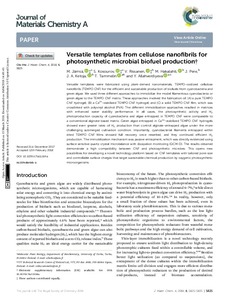| dc.contributor.author | Allahverdiyeva Y | |
| dc.contributor.author | Kosourov S | |
| dc.contributor.author | Pere J | |
| dc.contributor.author | Jämsä M | |
| dc.contributor.author | Rissanen V | |
| dc.contributor.author | Ketoja JA | |
| dc.contributor.author | Tammelin T | |
| dc.contributor.author | Hakalahti M | |
| dc.date.accessioned | 2022-10-28T13:36:39Z | |
| dc.date.available | 2022-10-28T13:36:39Z | |
| dc.identifier.uri | https://www.utupub.fi/handle/10024/166182 | |
| dc.description.abstract | Versatile templates were fabricated using plant-derived nanomaterials, TEMPO-oxidized cellulose nanofibrils (TEMPO CNF) for the efficient and sustainable production of biofuels from cyanobacteria and green algae. We used three different approaches to immobilize the model filamentous cyanobacteria or green algae to the TEMPO CNF matrix. These approaches involved the fabrication of: (A) a pure TEMPO CNF hydrogel; (B) a Ca<sup>2+</sup>-stabilized TEMPO CNF hydrogel; and (C) a solid TEMPO CNF film, which was crosslinked with polyvinyl alcohol (PVA). The different immobilization approaches resulted in matrices with enhanced water stability performance. In all cases, the photosynthetic activity and H<sub>2</sub> photoproduction capacity of cyanobacteria and algae entrapped in TEMPO CNF were comparable to a conventional alginate-based matrix. Green algae entrapped in Ca<sup>2+</sup>-stabilized TEMPO CNF hydrogels showed even greater rates of H<sub>2</sub> production than control alginate-entrapped algae under the more challenging submerged cultivation condition. Importantly, cyanobacterial filaments entrapped within dried TEMPO CNF films showed full recovery once rewetted, and they continued efficient H<sub>2</sub> production. The immobilization mechanism was passive entrapment, which was directly evidenced using surface sensitive quartz crystal microbalance with dissipation monitoring (QCM-D). The results obtained demonstrate a high compatibility between CNF and photosynthetic microbes. This opens new possibilities for developing a novel technology platform based on CNF templates with tailored pore-size and controllable surface charges that target sustainable chemical production by oxygenic photosynthetic microorganisms.<br /> | |
| dc.language.iso | en | |
| dc.publisher | ROYAL SOC CHEMISTRY | |
| dc.title | Versatile templates from cellulose nanofibrils for photosynthetic microbial biofuel production | |
| dc.identifier.url | http://xlink.rsc.org/?DOI=C7TA11164A | |
| dc.identifier.urn | URN:NBN:fi-fe2021042718959 | |
| dc.relation.volume | 6 | |
| dc.contributor.organization | fi=PÄÄT Molekulaarinen kasvibiologia|en=PÄÄT Molecular Plant Biology| | |
| dc.contributor.organization-code | 2606205 | |
| dc.converis.publication-id | 30494629 | |
| dc.converis.url | https://research.utu.fi/converis/portal/Publication/30494629 | |
| dc.format.pagerange | 5825 | |
| dc.format.pagerange | 5835 | |
| dc.identifier.jour-issn | 2050-7488 | |
| dc.okm.affiliatedauthor | Kosourov, Sergey | |
| dc.okm.affiliatedauthor | Allahverdiyeva-Rinne, Yagut | |
| dc.okm.affiliatedauthor | Jämsä, Mikael | |
| dc.okm.discipline | 216 Materiaalitekniikka | fi_FI |
| dc.okm.discipline | 219 Environmental biotechnology | en_GB |
| dc.okm.discipline | 216 Materials engineering | en_GB |
| dc.okm.discipline | 219 Ympäristön bioteknologia | fi_FI |
| dc.okm.discipline | 220 Industrial biotechnology | en_GB |
| dc.okm.discipline | 220 Teollinen bioteknologia | fi_FI |
| dc.okm.discipline | 1183 Kasvibiologia, mikrobiologia, virologia | fi_FI |
| dc.okm.discipline | 1183 Plant biology, microbiology, virology | en_GB |
| dc.okm.internationalcopublication | not an international co-publication | |
| dc.okm.internationality | International publication | |
| dc.okm.type | Journal article | |
| dc.publisher.country | Britannia | fi_FI |
| dc.publisher.country | United Kingdom | en_GB |
| dc.publisher.country-code | GB | |
| dc.relation.doi | 10.1039/C7TA11164A | |
| dc.relation.ispartofjournal | Journal of Materials Chemistry A | |
| dc.relation.issue | 14 | |
| dc.year.issued | 2018 | |
